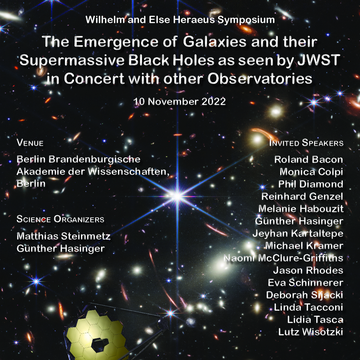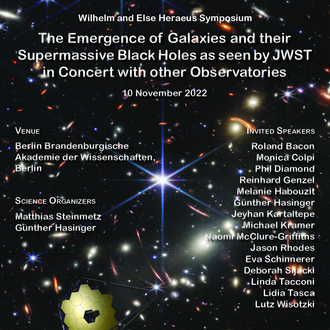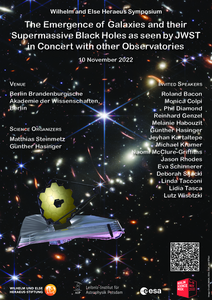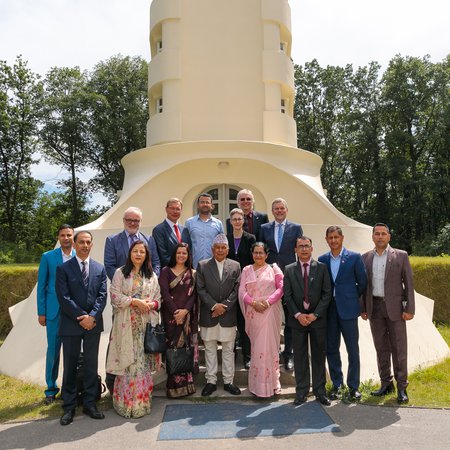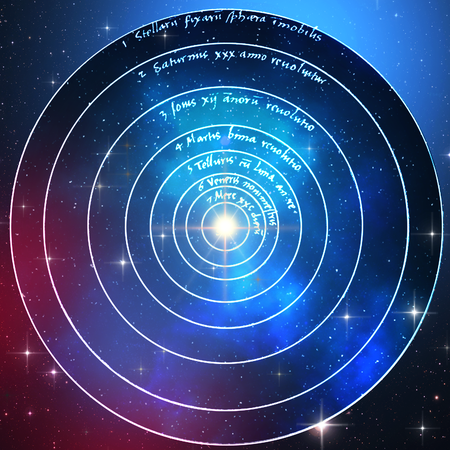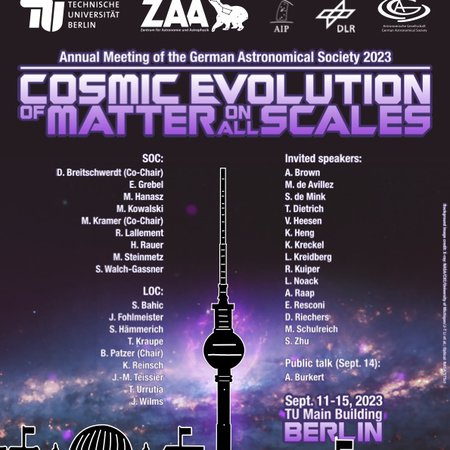The Emergence of Galaxies and their Supermassive Black Holes as seen by JWST
On 10 November at the Berlin Brandenburg Academy of Sciences, leading researchers in the field of galaxy evolution will discuss the first results and future prospects of the James Webb Space Telescope (JWST) together with other observatories in a dedicated Wilhelm and Else Heraeus Symposium. The event is part of Berlin Science Week.
The symposium intends to take the start of the JWST science programme as an opportunity to have a holistic view on the field of galaxy evolution and some of its driving facilities presented by some of the leading researchers in the field. Scientific organizers of the high-profile symposium are Professor Matthias Steinmetz, scientific chairman and spokesman for the Executive Board at the Leibniz Institute for Astrophysics Potsdam (AIP), and Professor Günther Hasinger, Director of Science at the European Space Agency ESA. Nobel laureate Professor Reinhard Genzel will be among the speakers.
JWST with its 6.5m mirror will be the prime space-based observing platform for astronomers in the coming decades. After more than 25 years of preparation and construction, JWST was successfully launched on 25 December 2021 and is approaching its full science operation capability. With the progress in commissioning, the focus is now shifting to the science exploitation of the unique capabilities of JWST. “Studying the emergence of the galaxy population and its supermassive black holes from the “dark ages” to the present epoch is one of the main science cases for JWST. However, such studies can only unfold their full potential, if they are properly combined with other wavelength studies thus employing a whole array of leading facilities, ground based as well as space missions,” said Matthias Steinmetz. “The focus is on facilities in operation and under construction, but the symposium will also give a first look what is being anticipated for the next decade.”
Programme:
08:00 Registration
09:00 Matthias Steinmetz, AIP Potsdam: Welcome and Introduction; Stefan Jorda, WE-Heraeus-Stiftung: Welcome Address
09:15 Jeyhan Kartaltepe, Rochester Institute of Technology: What has JWST Taught us About Galaxy Structure in the Early Universe?
09:45 Eva Schinnerer, Max Planck Institute for Astronomy: Uncovering Cloud and Star Formation in Nearby Galaxies with JWST
10:15 Linda Tacconi, Max Planck Institute for Extraterrestrial Physics: A (Sub)mm View of Galaxy Formation and Evolution
10:45 Coffee break
11:15 Reinhard Genzel, Max Planck Institute for Extraterrestrial Physics: The Formation and Early Evolution of Galaxies and their Central Black Holes (ONLINE)
11:45 Lutz Wisotzki, AIP Potsdam: Mapping the Gas around Galaxies with MUSE and HETDEX
12:15 Debora Sijacki, U Cambridge: Unveiling the Emergence of First Galaxies and Supermassive Black Holes with Cosmological Simulations in the JWST Era
12:45 Lunch
14:00 Melanie Habouzit, Max Planck Institute for Astronomy: Massive Black Holes across Cosmic Time: What Will We Learn from JWST and Other Next-generation Facilities
14:30 Alberto Sesana, U Milan Gravitational Wave Astronomy: – Studying Supermassive Black Holes with LISA
15:00 Jason Rhodes, Jet Propulsion Laboratory, NASA Surveying the IR Cosmos with ESA’s Euclid
15:30 Phil Diamond, DG Square Kilometre Array: The Impact of the Square Kilometre Array on the Study of the Emergence of Galaxies in our Universe
16:00 Coffee break
16:30 Lidia Tasca, Laboratoire d'Astrophysique de Marseille: MOSAIC: The Multi-object Spectrograph for the ESO Extremely Large Telescope
17:00 Roland Bacon, CRAL: WST – The Wide Field Spectroscopic Telescope
17:30 Michael Kramer, Max Planck Institute for Radio Astronomy: JWST in the German Astronomy Landscape
18:00 Günther Hasinger, ESA: Paving the Way to a New Center for Astrophysics in Lusatia (DZA)
18:30 Reception
19:30 End
Further information
Berlin Science Week
WE-Heraeus-Stiftung
On 10 November at the Berlin Brandenburg Academy of Sciences, leading researchers in the field of galaxy evolution will discuss the first results and future prospects of the James Webb Space Telescope (JWST) together with other observatories in a dedicated Wilhelm and Else Heraeus Symposium. The event is part of Berlin Science Week.
The symposium intends to take the start of the JWST science programme as an opportunity to have a holistic view on the field of galaxy evolution and some of its driving facilities presented by some of the leading researchers in the field. Scientific organizers of the high-profile symposium are Professor Matthias Steinmetz, scientific chairman and spokesman for the Executive Board at the Leibniz Institute for Astrophysics Potsdam (AIP), and Professor Günther Hasinger, Director of Science at the European Space Agency ESA. Nobel laureate Professor Reinhard Genzel will be among the speakers.
JWST with its 6.5m mirror will be the prime space-based observing platform for astronomers in the coming decades. After more than 25 years of preparation and construction, JWST was successfully launched on 25 December 2021 and is approaching its full science operation capability. With the progress in commissioning, the focus is now shifting to the science exploitation of the unique capabilities of JWST. “Studying the emergence of the galaxy population and its supermassive black holes from the “dark ages” to the present epoch is one of the main science cases for JWST. However, such studies can only unfold their full potential, if they are properly combined with other wavelength studies thus employing a whole array of leading facilities, ground based as well as space missions,” said Matthias Steinmetz. “The focus is on facilities in operation and under construction, but the symposium will also give a first look what is being anticipated for the next decade.”
Programme:
08:00 Registration
09:00 Matthias Steinmetz, AIP Potsdam: Welcome and Introduction; Stefan Jorda, WE-Heraeus-Stiftung: Welcome Address
09:15 Jeyhan Kartaltepe, Rochester Institute of Technology: What has JWST Taught us About Galaxy Structure in the Early Universe?
09:45 Eva Schinnerer, Max Planck Institute for Astronomy: Uncovering Cloud and Star Formation in Nearby Galaxies with JWST
10:15 Linda Tacconi, Max Planck Institute for Extraterrestrial Physics: A (Sub)mm View of Galaxy Formation and Evolution
10:45 Coffee break
11:15 Reinhard Genzel, Max Planck Institute for Extraterrestrial Physics: The Formation and Early Evolution of Galaxies and their Central Black Holes (ONLINE)
11:45 Lutz Wisotzki, AIP Potsdam: Mapping the Gas around Galaxies with MUSE and HETDEX
12:15 Debora Sijacki, U Cambridge: Unveiling the Emergence of First Galaxies and Supermassive Black Holes with Cosmological Simulations in the JWST Era
12:45 Lunch
14:00 Melanie Habouzit, Max Planck Institute for Astronomy: Massive Black Holes across Cosmic Time: What Will We Learn from JWST and Other Next-generation Facilities
14:30 Alberto Sesana, U Milan Gravitational Wave Astronomy: – Studying Supermassive Black Holes with LISA
15:00 Jason Rhodes, Jet Propulsion Laboratory, NASA Surveying the IR Cosmos with ESA’s Euclid
15:30 Phil Diamond, DG Square Kilometre Array: The Impact of the Square Kilometre Array on the Study of the Emergence of Galaxies in our Universe
16:00 Coffee break
16:30 Lidia Tasca, Laboratoire d'Astrophysique de Marseille: MOSAIC: The Multi-object Spectrograph for the ESO Extremely Large Telescope
17:00 Roland Bacon, CRAL: WST – The Wide Field Spectroscopic Telescope
17:30 Michael Kramer, Max Planck Institute for Radio Astronomy: JWST in the German Astronomy Landscape
18:00 Günther Hasinger, ESA: Paving the Way to a New Center for Astrophysics in Lusatia (DZA)
18:30 Reception
19:30 End
Further information
Berlin Science Week
WE-Heraeus-Stiftung
Images
Conference poster.
Big screen size [1000 x 1414, 2.0 MB]
Original size [1169 x 1654, 2.6 MB]
